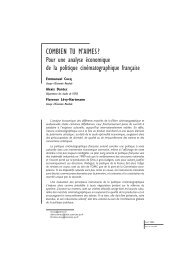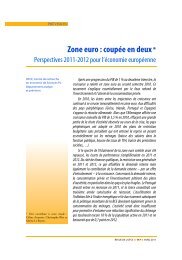direct multi-step estimation and forecasting - OFCE - Sciences Po
direct multi-step estimation and forecasting - OFCE - Sciences Po
direct multi-step estimation and forecasting - OFCE - Sciences Po
Create successful ePaper yourself
Turn your PDF publications into a flip-book with our unique Google optimized e-Paper software.
Direct <strong>multi</strong>-<strong>step</strong> <strong>estimation</strong> <strong>and</strong> <strong>forecasting</strong><br />
Discussion<br />
Although Stoica <strong>and</strong> Nehorai do not make explicit the difference between the model parameters<br />
<strong>and</strong> their powered-up <strong>multi</strong>-<strong>step</strong> counterparts, they show the importance of the hypothesis of<br />
model misspecification as a justification for the use of DMS. Here, it is the same model which is<br />
used at all forecast horizons, but the <strong>estimation</strong> method matches the desired outcome. In their<br />
simulations, the authors find that an ARMA(2, 2) estimated by an AR(1) model can lead to more<br />
accurate forecasts when using DMS. Their conclusion relating to under-parameterization mirrors<br />
that of Bhansali (1999); it is surprising that the very specific form of DGP they use should not<br />
strike them: it exhibits a root close to unity. It is thus possible that non-stationarity may appear<br />
as a feature benefitting DMS.<br />
5 Efficiency in matching criteria for <strong>estimation</strong> <strong>and</strong> forecast<br />
evaluation.<br />
Analyzing the ARIMA time series reported in Madrikakis (1982), Weiss <strong>and</strong> Andersen (1984) compare<br />
the <strong>forecasting</strong> properties of various <strong>estimation</strong> methods when the forecast accuracy criterion<br />
varies. In particular, they compare the one-<strong>step</strong> <strong>and</strong> <strong>multi</strong>-<strong>step</strong> ahead forecasts. They find that<br />
when a one-<strong>step</strong> ahead forecast accuracy loss function is used, it is preferable to use one-<strong>step</strong><br />
ahead <strong>estimation</strong> (<strong>and</strong> then OLS, Least-Absolute Deviation seem similar for either MSFE or Mean<br />
Absolute Error (MAE) criteria). Similarly, when the forecast accuracy is measured by the absolute<br />
percentage trace of a matrix of the forecast errors at several horizons, the best amongst the four<br />
<strong>estimation</strong> methods which they use (the <strong>multi</strong>-<strong>step</strong> trace, one-<strong>step</strong> ahead OLS, one-<strong>step</strong> MAE <strong>and</strong><br />
one-<strong>step</strong> Mean Absolute Percentage Error) is the <strong>multi</strong>-<strong>step</strong> trace. They, thus, find some significant<br />
improvement from matching <strong>estimation</strong> <strong>and</strong> <strong>forecasting</strong> horizons.<br />
Weiss (1991) builds upon the earlier work on <strong>multi</strong>-<strong>step</strong> <strong>estimation</strong> for <strong>forecasting</strong> <strong>and</strong> derives<br />
conditions under which this technique is asymptotically ‘optimal’, in a sense that he defines. He<br />
builds on the work by Johnston, where, in model (6), he allows for more lags of the endogenous<br />
14








